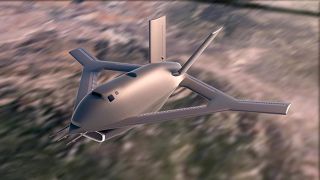
Artist’s rendering of DARPA’s experimental X-65 CRANE aircraft being build by Aurora Flight Sciences.
(Image credit: DARPA)
DARPA and Aurora Flight Sciences have begun building the first full-scale X-65 aircraft to demonstrate a new method of flight control that uses no external moving parts.
The X-65 is an experimental jet being developed by the Control of Revolutionary Aircraft with Novel Effectors (CRANE) program overseen by DARPA, (Defense Advanced Research Projects Agency), the Pentagon’s research and development agency. Since the first aircraft were invented, they have been controlled by moving surfaces such as rudders, flaps, elevators and ailerons.
The CRANE program aims to do away with these entirely and develop an aircraft controlled fully by jets of pressurized air that alter how the surrounding air flows over the aircraft while in flight.
Related: This wild DARPA CRANE X-plane could be a giant leap in aircraft design
However, in order to minimize risk, the first X-65 demonstrator will feature both conventional moving control surfaces and what are known as active flow control (AFC) actuators, the jets of pressurized air.
“The X-65 conventional surfaces are like training wheels to help us understand how AFC can be used in place of traditional flaps and rudders,” Richard Wlezien, program manager for CRANE, said in a DARPA statement. “We’ll have sensors in place to monitor how the AFC effector’s performance compares with traditional control mechanisms, and these data will help us better understand how AFC could revolutionize both military and commercial craft in the future.”
The X-65 will feature a 30-foot (9-meter) wingspan and weigh 7,000 pounds (3,200 kg), making it roughly the size of the T-38 trainer aircraft used by NASA astronauts and the U.S. military. It will be able to reach speeds of up to Mach 0.7, which DARPA says will “make the flight-test results immediately relevant to real world aircraft design.”
“The X-65 conventional surfaces are like training wheels to help us understand how AFC can be used in place of traditional flaps and rudders,” Wlezien said in the statement. “We’ll have sensors in place to monitor how the AFC effectors’ performance compares with traditional control mechanisms, and these data will help us better understand how AFC could revolutionize both military and commercial craft in the future.”
The X-65 will even feature a modular design, meaning its wings and active flow control systems will be able to be swapped out in the future, allowing it to be used for additional testing in the future after the conclusion of the CRANE program.
In the statement, DARPA says the X-65 could be completed and unveiled as soon as early 2025, with the first flight occurring as soon as summer of 2025.
Join our Space Forums to keep talking space on the latest missions, night sky and more! And if you have a news tip, correction or comment, let us know at: [email protected].
Breaking space news, the latest updates on rocket launches, skywatching events and more!
Brett is curious about emerging technologies, alternative launch concepts, anti-satellite technologies and uncrewed aircraft systems. Brett’s work has appeared on Scientific American, The War Zone, Popular Science, the History Channel, Science Discovery and more. Brett has English degrees from Clemson University and the University of North Carolina at Charlotte. In his free time, Brett enjoys skywatching throughout the dark skies of the Appalachian mountains.
>>> Read full article>>>
Copyright for syndicated content belongs to the linked Source : Space.com – https://www.space.com/darpa-crane-x-65-aircraft-aurora-flight-sciences




























![Forest ecology cannot be reduced to arithmetic, says M.I. Varghese [Interview] – Mongabay-India](https://earth-news.info/wp-content/uploads/2025/12/328946-forest-ecology-cannot-be-reduced-to-arithmetic-says-mi-varghese-interview-mongabay-india-120x86.jpg)


